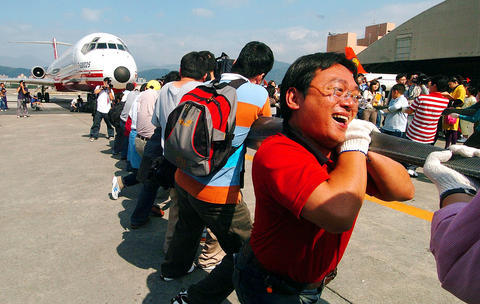Do you know how many people it takes to pull a MD-83 model passenger jet -- one equipped with 143 passenger seats and weighing 45 tonnes?
Thousands of people were eager to find out the answer yesterday morning as they gathered at a facility near the Taipei Songshan Airport to witness the potentially record-setting event.
The move was part of festivities organized by Far Eastern Air Transport Corp (

PHOTO: CHIEN JUNG-FUNG, TAIPEI TIMES
To encourage participation from the public, the company held an online quiz asking people to guess the number of people needed to move the airplane. The company later invited some of the respondents to participate in the event.
At first, fifteen participants were invited to try to pull the airplane. After they failed, another 10 people were added to the team. Again they failed.
After the third try, five people were added at a time. Eventually, the passenger jet moved 5m when pulled by a total of 50 people.
Far Eastern employees, led by chairman Mike Lo (樂大信), also formed a team to pull the airplane. Following the same set of rules, the Far Eastern team was able to pull the airplane with only 40 people.
A man surnamed Kan (
"Apparently, we are too weak," he said.
After his team accomplished the feat, Lo said that it is quite tiring to pull because it is difficult to hold the rope firmly. He said that he had thought that 10 people would be enough to pull the airplane.
Lo, however, is ready to take on another challenge.
"Maybe a Boeing 757," he said.
Yet, the biggest challenge Far Eastern is facing in its 50-year history is a shrinking domestic market and the launch of the high speed rail service.
The carrier said yesterday that it was evaluating the possibility of canceling all flights between Taipei and Tainan as the route has suffered continuous losses since the high speed rail opened in January.
Far Eastern president Philip Chen (陳尚群) said they hoped the flights to Tainan could end as soon as possible, though the proposal would need Civil Aeronautics Administration (CAA) approval.
On average Taipei-Tainan flights are only 30 percent full.
This month, the company decided to reduce Taipei-Tainan flights from three to two per day.
Hanson Chang (
However, they reacted warmly to the discount offered for the Taipei-Kaohsiung flights, he said.
Should the situation get worse, the company might even consider cutting the Taipei-Tainan flights to one a day during the Lunar New Year holidays next year, Chang said.
Chang said the operation of the Taipei-Tainan flights may continue if the airport in Tainan could be expanded into an international airport.
Even though the sale of the Taipei-Kaohsiung tickets is going well, Chang said it is only "a matter of time" before they withdraw completely from the domestic airline market.
Seventy percent of the company's revenue is now earned through international flights, Chang said.
Chang also said that it is planning to provide one daily flight to Borneo starting in January.

WEAKER ACTIVITY: The sharpest deterioration was seen in the electronics and optical components sector, with the production index falling 13.2 points to 44.5 Taiwan’s manufacturing sector last month contracted for a second consecutive month, with the purchasing managers’ index (PMI) slipping to 48, reflecting ongoing caution over trade uncertainties, the Chung-Hua Institution for Economic Research (CIER, 中華經濟研究院) said yesterday. The decline reflects growing caution among companies amid uncertainty surrounding US tariffs, semiconductor duties and automotive import levies, and it is also likely linked to fading front-loading activity, CIER president Lien Hsien-ming (連賢明) said. “Some clients have started shifting orders to Southeast Asian countries where tariff regimes are already clear,” Lien told a news conference. Firms across the supply chain are also lowering stock levels to mitigate

Six Taiwanese companies, including contract chipmaker Taiwan Semiconductor Manufacturing Co (TSMC, 台積電), made the 2025 Fortune Global 500 list of the world’s largest firms by revenue. In a report published by New York-based Fortune magazine on Tuesday, Hon Hai Precision Industry Co (鴻海精密), also known as Foxconn Technology Group (富士康科技集團), ranked highest among Taiwanese firms, placing 28th with revenue of US$213.69 billion. Up 60 spots from last year, TSMC rose to No. 126 with US$90.16 billion in revenue, followed by Quanta Computer Inc (廣達) at 348th, Pegatron Corp (和碩) at 461st, CPC Corp, Taiwan (台灣中油) at 494th and Wistron Corp (緯創) at

NEGOTIATIONS: Semiconductors play an outsized role in Taiwan’s industrial and economic development and are a major driver of the Taiwan-US trade imbalance With US President Donald Trump threatening to impose tariffs on semiconductors, Taiwan is expected to face a significant challenge, as information and communications technology (ICT) products account for more than 70 percent of its exports to the US, Chung-Hua Institution for Economic Research (CIER, 中華經濟研究院) president Lien Hsien-ming (連賢明) said on Friday. Compared with other countries, semiconductors play a disproportionately large role in Taiwan’s industrial and economic development, Lien said. As the sixth-largest contributor to the US trade deficit, Taiwan recorded a US$73.9 billion trade surplus with the US last year — up from US$47.8 billion in 2023 — driven by strong

ASE Technology Holding Co (ASE, 日月光投控), the world’s biggest chip assembly and testing service provider, yesterday said it would boost equipment capital expenditure by up to 16 percent for this year to cope with strong customer demand for artificial intelligence (AI) applications. Aside from AI, a growing demand for semiconductors used in the automotive and industrial sectors is to drive ASE’s capacity next year, the Kaohsiung-based company said. “We do see the disparity between AI and other general sectors, and that pretty much aligns the scenario in the first half of this year,” ASE chief operating officer Tien Wu (吳田玉) told an